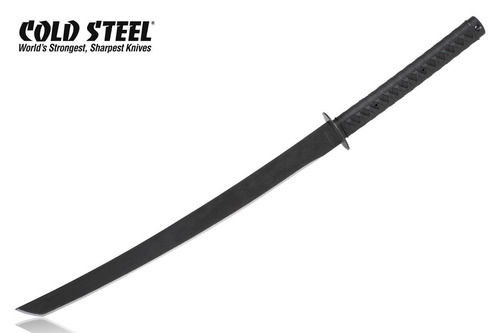
- COLD STEEL KATANA MACHETE MODIFICATIONS MANUAL
- COLD STEEL KATANA MACHETE MODIFICATIONS FULL
- COLD STEEL KATANA MACHETE MODIFICATIONS SERIES
Non-European weapons classified as swords include single-edged weapons such as the Middle Eastern scimitar, the Chinese dao and the related Japanese katana. The US Navy kept tens of thousands of sturdy cutlasses in their armory well into World War II and many were issued to Marines in the Pacific as jungle machetes. Sabres continued to see battlefield use until the early 20th century. Most sabres also had sharp points and double-edged blades, making them capable of piercing soldier after soldier in a cavalry charge. Built for slashing and chopping at multiple enemies, often from horseback, the sabre's long curved blade and slightly forward weight balance gave it a deadly character all its own on the battlefield. The sabre and similar blades such as the cutlass were built more heavily and were more typically used in warfare. A well aimed lunge and thrust could end a fight in seconds with just the sword's point, leading to the development of a fighting style which closely resembles modern fencing. Their long and straight yet light and well balanced design made them highly maneuverable and deadly in a duel but fairly ineffective when used in a slashing or chopping motion. Thrusting swords such as the rapier and eventually the smallsword were designed to impale their targets quickly and inflict deep stab wounds.

In the early modern period, western sword design diverged into two forms, the thrusting swords and the sabres. The use of a sword is known as swordsmanship or, in a modern context, as fencing.

The word sword continues the Old English, sweord. The spatha, as it developed in the Late Roman army, became the predecessor of the European sword of the Middle Ages, at first adopted as the Migration Period sword, and only in the High Middle Ages, developed into the classical arming sword with crossguard. The later Iron Age sword remained fairly short and without a crossguard. Historically, the sword developed in the Bronze Age, evolving from the dagger the earliest specimens date to about 1600 BC. The precise definition of a sword varies by historical epoch and geographic region. Many swords are designed for both thrusting and slashing. A slashing sword is more likely to be curved and to have a sharpened cutting edge on one or both sides of the blade. A thrusting sword tends to have a straighter blade with a pointed tip. Its blade, longer than a knife or dagger, is attached to a hilt and can be straight or curved.
COLD STEEL KATANA MACHETE MODIFICATIONS MANUAL
sword is an edged, bladed weapon intended for manual cutting or thrusting. Steel: 1055 Carbon Steel with Black Baked-On Anti Rust Matte Finish

Fully sharpened in Cold Steel's Ventura HQ, the Tactical Katana Machete comes complete with a Cor-Ex back sheath for ease of carry and storage.

We spared no expense to re-create the look of a traditional cord wrapped handle, fushi and kashira but using modern materials that will not shrink, warp, tarnish or rot and require very little maintenance to retain peak performance.
COLD STEEL KATANA MACHETE MODIFICATIONS FULL
With its deeply curved blade, it offers more "sword-like" cutting performance, and with its broad full tang, solid steel tsuba and injection over-molded high impact polymer handle its incredible durable.
COLD STEEL KATANA MACHETE MODIFICATIONS SERIES
The latest addition to the Cold Steel Katana Machete series, the Tactical Katana is closely modeled after the hugely popular and record breaking Warrior Series Katana.


 0 kommentar(er)
0 kommentar(er)
